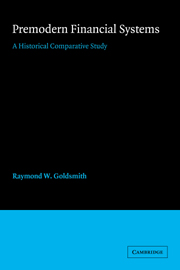Book contents
- Frontmatter
- Contents
- List of tables
- Preface
- 1 Introduction
- 2 The financial systems of the ancient Near East
- 3 The financial system of Periclean Athens
- 4 The financial system of Augustan Rome
- 5 The financial system of the early Abbasid caliphate
- 6 The financial system of the Ottoman Empire at the death of Suleiman I
- 7 The financial system of Mughal India at the death of Akbar
- 8 The financial system of early Tokugawa Japan
- 9 The financial system of Medici Florence
- 10 The financial system of Elizabethan England
- 11 The financial system of the United Provinces at the Peace of Münster
- 12 Similarities and differences
- Notes
- Bibliography
- Index
9 - The financial system of Medici Florence
Published online by Cambridge University Press: 05 March 2012
- Frontmatter
- Contents
- List of tables
- Preface
- 1 Introduction
- 2 The financial systems of the ancient Near East
- 3 The financial system of Periclean Athens
- 4 The financial system of Augustan Rome
- 5 The financial system of the early Abbasid caliphate
- 6 The financial system of the Ottoman Empire at the death of Suleiman I
- 7 The financial system of Mughal India at the death of Akbar
- 8 The financial system of early Tokugawa Japan
- 9 The financial system of Medici Florence
- 10 The financial system of Elizabethan England
- 11 The financial system of the United Provinces at the Peace of Münster
- 12 Similarities and differences
- Notes
- Bibliography
- Index
Summary
Florence was the most important financial center during most of the fourteenth and fifteenth centuries not only in Italy but also in Western Europe (de Roover 1963 p. 125). Within that period concentration on the first half of the fifteenth century is indicated by the preservation and recent tabulation of the about 60,000 schedules of the property census (catasto) of 1427, a document with a scope and detail rarely equaled, certainly not before the nineteenth century.
Any consideration of the financial system of the Florentine Republic in that period will have to take account of at least four basic facts. First, the Republic was one of the smaller Italian states. Even after a considerable extension of its territory during the first quarter of the fifteenth century, it covered only 11,000 km2 (Herlihy and Klapisch-Zuber, p. 110), or 4 percent of the area of Italy, and with a population of about 300,000 inhabitants accounted for the same small proportion of its population ranking behind Venice, Milan, Genoa, the papal states, and the kingdom of Naples. Second, while Florence was the leading financial center of the peninsula and an important commercial and industrial city, it was surpassed by Venice and Genoa in overseas trade and in contrast to them had no colonies.
- Type
- Chapter
- Information
- Premodern Financial SystemsA Historical Comparative Study, pp. 145 - 170Publisher: Cambridge University PressPrint publication year: 1987



